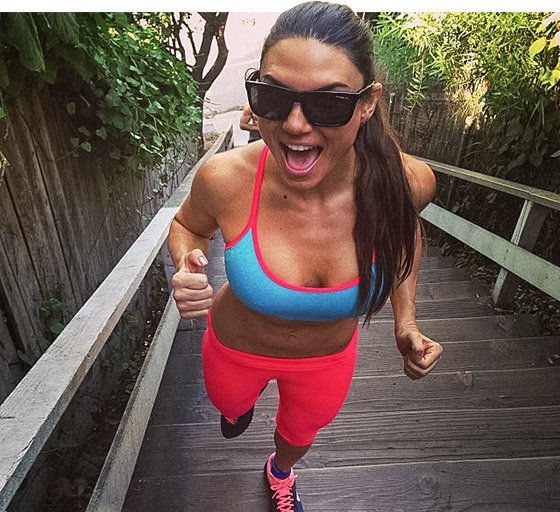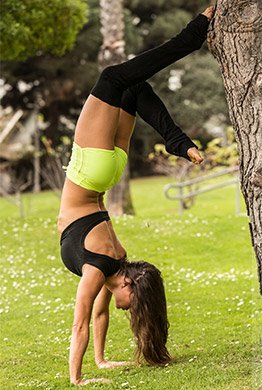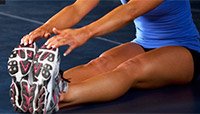Summer's upon us and, I don't know about you guys, but I'm in beach-body-sculpting mode! The weather gets warmer and the clothes come off piece by piece, a toned body and great tan lines are a necessity!
As an outdoor-fitness fanatic, I do everything I can to take my workouts into the clean air, with the breeze blowing through my hair. And why not? The benefits of outdoor exercise extend beyond the workout. Outdoor workouts have been shown to improve your mood, clear your mind, and alleviate stress and anxiety more than their indoor counterparts.1,2
Not sure how to carve out your own fitness path and make the elements your playground? Use these tips to fuel your motivation, shape your summer body, and elevate your mood.
1
Outdoor Stair and
Stadium Session
Move over, stair stepper. Take your routine outdoors to put a new spin on working up a sweat. Whether you find some stairs in a local neighborhood or cruise into a high school stadium and dare yourself to climb up to the nosebleed section and back down, you're sure to get an epic booty-blasting workout!
Here are some insider secrets I use to step up my game. Try and implement them into your training and you'll reach the top before you know it.
Alternate Between Running And Lunging
I alternate between running and lunging every round (one trip up and back down). For the first round, I skip a level of stairs to create a high box/lunge sensation. I skip two levels most of the time to create a super-long lunge stretch and increase the intensity of the step-up, better activating my glutes, hamstrings, and thighs.
You can do this too, but you'll need to get your legs warmed up and accustomed to the movement before you start skipping stairs. The key is to keep the weight in your heel, not your toes. Isolating the weight in your heel will activate your glutes and get your booty ready for the bikini or board shorts you want to wear this summer!

Keep Weight In Your Toes For Calf Activation
I run my second set of stairs as intensely as possible, and I always make sure I reach the top without stopping. During this set, I focus on putting my weight on my toes. By doing this, I activate my calf muscles and give my glutes a break. Changing your method of getting to the top ensures that you target and isolate different muscles during each climb instead of just going through the same movements.
Activate Your Abs
When I'm coming down the stairs, I pace myself to go as fast and safely as I can. I engage my abs the entire way. You can do this by bracing your abdominal wall—tensing up as if you were expecting someone to punch you in the gut. Visualize pulling your belly button into your spine, and keep it tight. Just stay mindful and never let yourself fall prey to a "loose tummy."
2
Stand-up Paddle Boarding (SUP) and Surfing
It's time to get your hair wet and face your fears in the water! Whether you live by the ocean and have access to some descent surf, or you're near lakes or rivers, some of the best times you'll have outdoors are when you're able to make a splash. Stand-up paddle boarding (SUP) is now the fastest growing water sport in the world. It's finally allowed those of us who always dreamed of being surfers to dive into the deeper parts of the open waters and explore.
SUP and surfing in general rank high among my favorite exercises. They're great for body sculpting and, when done correctly and with intensity, both activities are cardio driven, full-body workouts.

Plus, they're both fun to do with family, friends, or your significant other. Experience on the water brings about deeper connections—and that little adrenaline rush and added challenge has a unique ability to create strong bonds. Let me just say, paddling buddies make for epic friends.
SUP is my go-to sport to get me looking like a lean mean athletic machine. Looking to get your feet wet? Hang 10 with these tips:
Stand-up Paddle Boarding Engage Your Abs
This might sound like a no brainer, but a tight core is the key to stabilization. With stand-up paddle boarding, your abs should always be engaged to help activate stability on the board. When it comes to form, paddling with a mini bend in your knees puts your legs and glutes in a squat position, spelling major booty activation and quad burn. The resistance pull from each stroke means shredded arms and shoulders.
Surfing Shred Your Upper Body
Surfing is by far the hardest sport in the world, and has the steepest learning curve, but who doesn't want to be an amazing surfer? I know I do. I still dream of the day I'll lay it down in a barrel and see the light at the end of the tunnel.
Even if you don't aspire to conquer the next big wave, surfing's a great way to shred your upper body, specifically your shoulders and back. Every time you pop up to catch a wave, you put yourself in a plank position (known as chadaranga in yoga). This adds crazy definition to your biceps and abs. When paddling correctly, you fire your shoulder muscles and lats. An added bonus: If you keep your legs in correct alignment, you engage your back and tone it, too. You'll get in all of your cardio and then some when intense waves force you to keep your head above water.
3
Beach, Street, or Park Yoga

Yoga is my tried and true body sculptor. It keeps me lean and limber. I always hear people say "I can't do yoga because I'm not flexible." That's like saying "I can't go to the gym because I'm not strong enough." The reason we do yoga is to practice and increase flexibility of both the mind and body.
With the sun shining and weather warming up, why not take your yoga outside? Just kick off the ol' shoes and drop into a sweaty sun salutation. Tone and rejuvenate your body with a series of Serya Namasakar A, also known as the sun salutation. Take advantage of being surrounded by nature. Use trees to practice your handstands, headstands, and hanging splits. Much like a wall, they'll help you balance while practicing inverted moves.
Yoga heals the body internally. Many of the poses in yoga are isometric muscle holds that stretch your ligaments and muscles; this generates internal heat and causes you to sweat while ridding your body of toxins. It's a wonderful toning exercise and a natural way to detoxify the body.
When doing yoga outside, make sure you find a flat space that will lend itself to the stability needed for your poses. Here are some key tips that I always remind my yogis to be conscious of:
Keep A Tight Core
Always be mindful of having your core engaged and your focus ahead of you. When we practice yoga, we practice holding ourselves in "stature." Holding yourself in stature is important for good posture and keeps back aches at bay. You'll avoid hunched-over shoulders, lengthen and strengthen your physique, and give off a clear sign of confidence that's sure to translate into your day-to-day life.

Breathe Deep
Always find a rhythmic breath through the nose, while keeping your mouth closed. Practicing this will deepen your breathing cycle, which will transfer over to the way you inhale and exhale during workouts. It's guaranteed to create a fluid and calm breathing pattern that will help break the tendency to resort to short, choppy breaths during intense workouts.
Keep Your Shoulders Back
Always keep your shoulders back instead of rounded forward. This bad form can cause serious posture damage. Use yoga to help correctly align your body, lengthen your spine, and correct concaved shoulders. Be mindful of this shoulder posture both in and outside of the gym.
Listen To Your Body
Know the difference between pain and progress. Yoga is an activity where pain equals growth, but only when it's the kind of pain that pushes you in the right places. Your yoga practice is exactly that, yours. There is no right level you need to reach. I'm a certified level 5 yogi and still can't do the intense splits that are in many yoga magazines.
Just know that the sooner you get comfortable being uncomfortable, the faster you'll see progress and growth—both physically and emotionally. By taking your yoga outside, you'll have Mother Nature as your studio. You can "get grounded" and feel that sense of peace and tranquility.
REFERENCES
- http://health.usnews.com/health-news/family-health/heart/articles/2008/06/23/time-in-the-sun-how-much-is-needed-for-vitamin-d
- http://www.epa.gov/region1/communities/indoorair.html
Recommended For You

6 Reasons To Shape Up For Summer
A heavy winter doesn't have to leave your motivation on ice. Reignite your passion for fitness and carve your summer body now! Warm weather's right around the corner.
Summer Shredded: Get A Beach-Ready Body
Don't get caught with your shirt on when the weather warms up. Here's a six-week plan to make sure your physique turns plenty of heads this summer.

